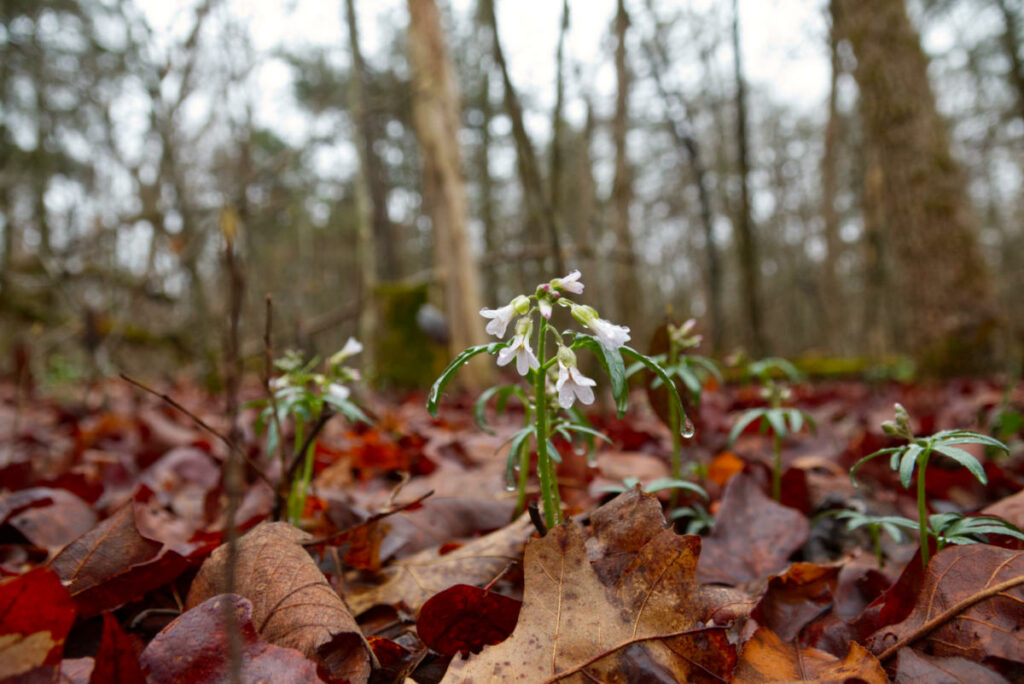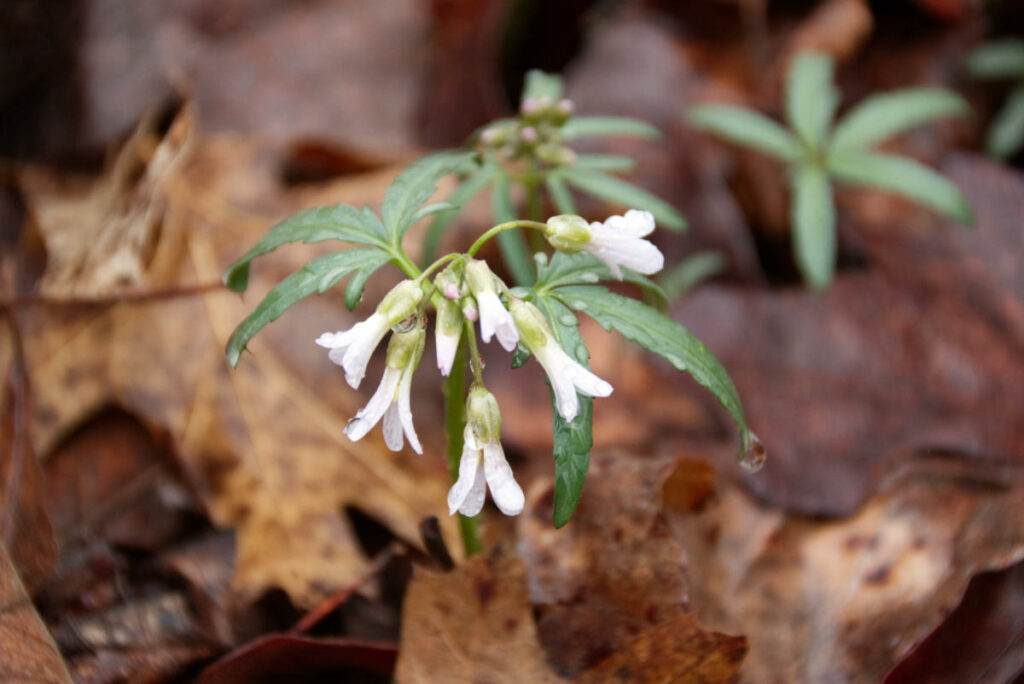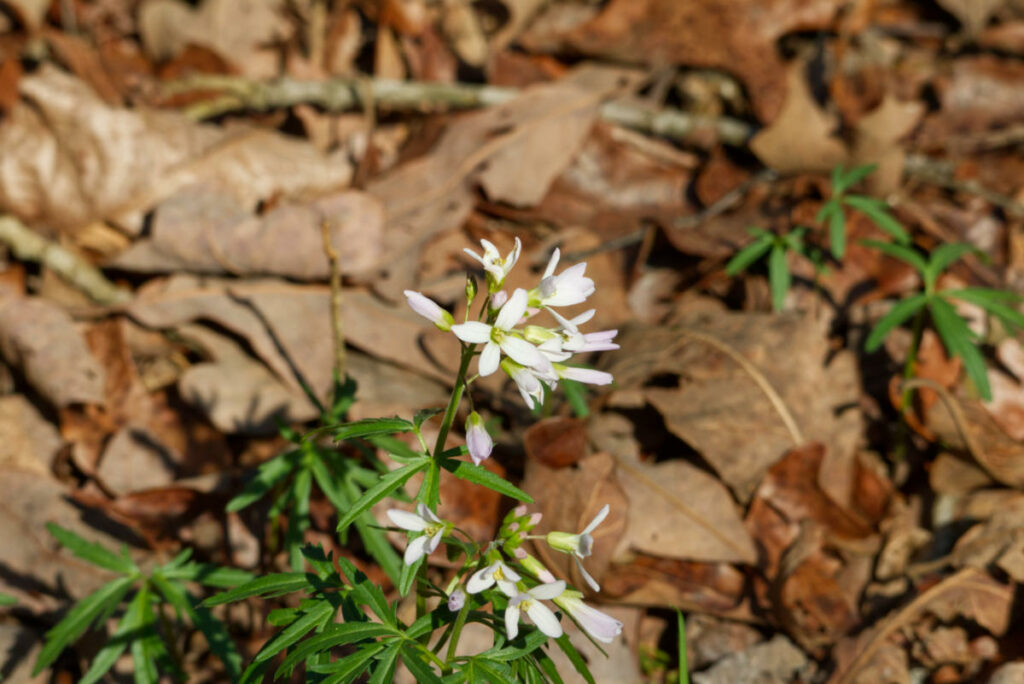
Have you ever considered adding a little bit of wildness to your plate? Look no further than cutleaf toothwort, a delightful wild plant that can spice up your dishes with its unique flavor. In this article, we will explore the various ways of using cutleaf toothwort in the kitchen, from simple salads to elaborate entrees. Whether you’re a seasoned forager or a curious foodie, using cutleaf toothwort in the kitchen is a great way to experiment with new flavors and ingredients. So join us as we discover the culinary potential of this wild gem.
Cutleaf toothwort (Dentaria laciniata) is a wild plant commonly found in Eastern North America. This plant is a member of the Brassicaceae family, which also includes common vegetables like broccoli and cabbage. The young leaves of cutleaf toothwort can be consumed raw or cooked, and the plant also produces edible tubers that can be boiled or roasted.
To prepare cutleaf toothwort, start by harvesting the young leaves in early spring before the plant flowers. Rinse the leaves thoroughly in cold water and pat them dry with a paper towel. The leaves can be added raw to salads or sandwiches, or cooked in stir-fries, soups, or sautés. The tubers can be harvested in late summer or early fall and are best when roasted or boiled until tender.
Cutleaf toothwort has a mild, nutty flavor and can be used as a substitute for other leafy greens in recipes. It is also a good source of vitamin C, vitamin A, and calcium. When using cutleaf toothwort, be sure to only harvest from areas where the plant is abundant, and avoid harvesting from areas that may have been contaminated with pesticides or other harmful chemicals.
The Benefits of Cooking with Cutleaf Toothwort
Cutleaf toothwort is a great ingredient to have in your kitchen for a variety of reasons:
- It is a rich source of vitamins and minerals, including vitamins A and C, calcium, and iron.
- It has a unique, slightly bitter flavor that can add depth and complexity to your dishes.
- It is easy to prepare and can be used in a variety of recipes.
- It produces rhizomes that can be used as a substitute for horseradish.
How to Identify Cutleaf Toothwort

How to Identify Cutleaf Toothwort:
Before you can start cooking with Cutleaf toothwort, you need to know how to identify it. Here are a few key characteristics to look for:
- Tooth-shaped leaves with a distinctive serrated edge.
- Delicate white flowers that bloom in the spring.
- A stem that grows up to 12 inches tall.
Caution -Always make sure you are 100% certain of your identification when foraging wild plants for consumption. Get a good edible plant guide or consult an expert if you have any doubts.
Now that you know what to look for, let’s dive into some delicious recipes that incorporate Cutleaf toothwort.
Delicious Cutleaf Toothwort Recipes
Cutleaf Toothwort Soup
Ingredients:
- 1 bunch of Cutleaf toothwort greens, washed and chopped
- 1 onion, chopped
- 3 cloves of garlic, minced
- 2 cups of chicken or vegetable broth
- 1 cup of heavy cream
- 2 tablespoons of butter
- Salt and pepper, to taste
Instructions:
- Melt the butter in a large pot over medium heat. Add the chopped onion and garlic, and cook for 2-3 minutes until the onion becomes translucent.
- Add the chopped Cutleaf toothwort to the pot and cook for an additional 5 minutes, stirring occasionally.
- Pour the chicken or vegetable broth into the pot and bring to a boil. Reduce the heat to low and simmer for 15-20 minutes, or until the Cutleaf toothwort is tender.
- Use an immersion blender or transfer the soup to a blender, and puree until smooth.
- Return the pureed soup to the pot and add the heavy cream. Stir until the cream is fully incorporated.
- Season with salt and pepper to taste.
- Serve hot and enjoy the unique, slightly bitter flavor of Cutleaf toothwort in this delicious soup.
Note: You can also garnish with a sprinkle of fresh herbs or croutons for added texture and flavor.
Cutleaf Toothwort Salad
Ingredients:
- 1 bunch of Cutleaf toothwort greens, washed and chopped
- 1 head of lettuce, chopped
- 1 red onion, sliced
- 1 cup of cherry tomatoes, halved
- 1 avocado, diced
- 1/4 cup of olive oil
- 2 tablespoons of red wine vinegar
- 1 teaspoon of honey
- Salt and pepper, to taste
Instructions:
- In a large mixing bowl, combine the chopped Cutleaf toothwort, lettuce, sliced red onion, cherry tomatoes, and diced avocado.
- In a separate bowl, whisk together the olive oil, red wine vinegar, honey, salt, and pepper.
- Drizzle the dressing over the salad and toss until all the ingredients are well coated.
- Serve immediately and enjoy the fresh and flavorful combination of Cutleaf toothwort and other ingredients.
Note: You can add other ingredients like grilled chicken, crumbled feta cheese, or toasted nuts for added protein and texture.
Cutleaf Toothwort Pasta
Ingredients:
- 1 bunch of Cutleaf toothwort greens, washed and chopped
- 1 pound of pasta
- 3 tablespoons of olive oil
- 3 cloves of garlic, minced
- 1/2 cup of grated parmesan cheese
- Salt and pepper, to taste
Instructions:
- Cook the pasta according to the package instructions until al dente. Reserve 1/2 cup of the pasta water.
- While the pasta is cooking, heat the olive oil in a large skillet over medium heat. Add the minced garlic and cook for 1-2 minutes until fragrant.
- Add the chopped Cutleaf toothwort to the skillet and cook for 5-7 minutes until tender and slightly wilted.
- Add the cooked pasta and reserved pasta water to the skillet with the Cutleaf toothwort. Toss to combine and coat the pasta with the sauce.
- Add the grated parmesan cheese, salt, and pepper to taste. Toss again to evenly distribute the ingredients.
- Serve hot and enjoy the unique, slightly bitter flavor of Cutleaf toothwort in this delicious pasta dish.
Note: You can add other ingredients like cherry tomatoes, grilled chicken, or sautéed mushrooms for added flavor and nutrition.

Cutleaf Toothwort Stir-Fry
Ingredients:
- 1 bunch of Cutleaf toothwort greens, washed and chopped
- 1 pound of chicken breast, cut into small pieces
- 2 tablespoons of vegetable oil
- 3 cloves of garlic, minced
- 1 tablespoon of grated ginger
- 1 red bell pepper, sliced
- 1 onion, sliced
- 1 tablespoon of soy sauce
- 1 tablespoon of oyster sauce
- Salt and pepper, to taste
Instructions:
- Heat the vegetable oil in a wok or large skillet over high heat. Add the minced garlic and grated ginger, and stir-fry for 1-2 minutes until fragrant.
- Add the sliced chicken breast to the wok and stir-fry for 3-4 minutes until the chicken is no longer pink.
- Add the sliced red bell pepper and onion to the wok and stir-fry for an additional 2-3 minutes until the vegetables are tender-crisp.
- Add the chopped Cutleaf toothwort to the wok and stir-fry for 1-2 minutes until slightly wilted.
- In a small bowl, whisk together the soy sauce and oyster sauce. Pour the sauce over the stir-fry and toss to evenly coat all the ingredients.
- Season with salt and pepper to taste.
- Serve hot and enjoy the unique, slightly bitter flavor of Cutleaf toothwort in this delicious stir-fry dish.
Note: You can also add other vegetables like broccoli, snow peas, or carrots for added nutrition and color.
Cutleaf Toothwort Dessert
Cutleaf Toothwort is not commonly used in desserts, but here is a unique recipe that incorporates its slightly bitter flavor into a delicious and healthy treat.
Cutleaf Toothwort and Apple Crumble
Ingredients:
- 1 bunch of Cutleaf toothwort greens, washed and chopped
- 2 apples, peeled and chopped
- 1/2 cup of rolled oats
- 1/2 cup of almond flour
- 1/4 cup of maple syrup
- 1/4 cup of coconut oil, melted
- 1/2 teaspoon of cinnamon
- Pinch of salt
Instructions:
- Preheat the oven to 375°F (190°C).
- In a bowl, combine the chopped Cutleaf toothwort and apples. Spread the mixture evenly in a 9×9-inch baking dish.
- In another bowl, combine the rolled oats, almond flour, maple syrup, melted coconut oil, cinnamon, and salt. Mix well to form a crumbly mixture.
- Sprinkle the crumble mixture over the Cutleaf toothwort and apple mixture.
- Bake for 25-30 minutes, or until the crumble is golden brown and the apples are soft.
- Serve hot or cold with a dollop of whipped cream or vanilla ice cream, if desired.
Enjoy the unique flavor of Cutleaf toothwort in this healthy and delicious dessert!
There you have 5 delicious Cutleaf Toothwort recipes to try. Cutleaf Toothwort is an easy-to-identify wild edible that is abundant in the early Spring before the leaves return to the trees. In our area of the Ozarks, they are most plentiful in early to mid-March.
Be sure and check out our blog for more great articles.
FAQs:
Q: What are the edible and medicinal uses of cutleaf toothwort?
A: The roots and leaves of cutleaf toothwort are edible, with a peppery and slightly bitter taste. It has been used medicinally as a cough remedy, for treating rheumatism, and for inducing sweating.
Q: Where can I find cutleaf toothwort in the wild?
A: Cutleaf toothwort can be found in moist deciduous forests, often near streams or other water sources. It is most commonly found in eastern North America.
Q: What are some tips for harvesting and preparing cutleaf toothwort for consumption?
A: Cutleaf toothwort should be harvested in the spring, before the plant flowers. The leaves and roots can be eaten raw or cooked. It is best to rinse the plant thoroughly and remove any tough stems before consuming.
Q: Are there any precautions I should take when using cutleaf toothwort for cooking or medicinal purposes?
A: Cutleaf toothwort should not be consumed in large quantities, as it contains compounds that may cause digestive upset. As with any wild plant, be sure to properly identify it before consuming, and avoid any plants that appear damaged or diseased.
Q: Can cutleaf toothwort be grown in a garden or other cultivated area, or does it need to be foraged in the wild?
A: Cutleaf toothwort can be difficult to cultivate, as it requires specific growing conditions, such as a moist, shady environment. It is primarily foraged in the wild.
Q: How does the taste of cutleaf toothwort compare to other wild edible plants?
A: Cutleaf toothwort has a unique peppery and slightly bitter taste that is distinct from other wild edible plants.
Q: Are there any lookalike plants that could be confused with cutleaf toothwort, and if so, how can I tell them apart?
A: Cutleaf toothwort can be confused with other members of the toothwort family, such as early meadow-rue and early buttercup. However, cutleaf toothwort has distinctive leaves that are deeply cut and almost fern-like in appearance, which can help distinguish it from other similar plants.
Comments are closed